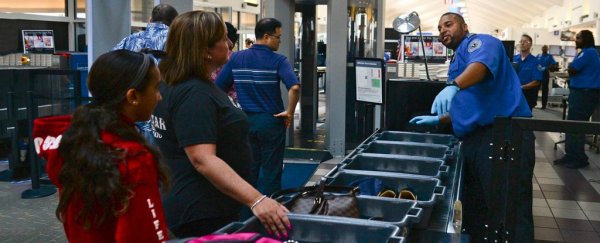Next time you go through airport security, it might be worth washing your hands afterward.
According to the results of a new study published by Finnish and British researchers, half of plastic airport security bins may carry viruses that cause respiratory infections.
The study, published last week in the BioMed Central Infectious Diseases journal, tested swabs from surface samples of the plastic bins at Helsinki Airport that were taken at three different times during the peak of the 2015-2016 flu season.
Four of 8 samples contained the rhinovirus or adenovirus, which both cause cold-like symptoms.
The lead authors of the article, who hailed from Finland's National Institute for Health and Welfare and the University of Nottingham, concluded that the screening trays "appear commonly contaminated," and that they are one of the surfaces at an airport where passengers are most likely to pick up harmful viruses.
"We found the highest frequency of respiratory viruses on plastic trays used in security check areas for depositing hand-carried luggage and personal items," the scientists wrote in their journal article.
"These boxes typically cycle with high frequency to subsequent passengers, and are typically seized with a wide palm surface area and strong grip."
The results, they said, demonstrated that airports can serve as a potential risk-zone for an "emerging pandemic threat" - a prospect that has already become a major concern in the aftermath of the 2002 SARS outbreak, and the 2014 Ebola epidemic.
And the preponderance of viruses on airport screening bins may be even more cause for concern among Americans, who are increasingly encountering Transportation Security Administration screeners instructing them to empty their food and snack items straight into the plastic bins.
At the conclusion of the study centered on Helsinki Airport, the researchers concluded that airports should offer hand sanitizer to travelers before and after each security checkpoint, and that the baggage trays should be cleaned and disinfected more frequently.
"This knowledge helps in the recognition of hot spots for contact transmission risk, which could be important during an emerging pandemic threat or severe epidemic," the scientists wrote in the article.
But plastic bins aren't the only place in airports where researchers found frequent presence of cold-causing viruses.
On the buttons of the Helsinki Airport pharmacy's payment terminal, 50 percent of samples tested positive for the rhinovirus or the human coronavirus.
Of the samples taken at the desks and glass dividers at the airport's passport control checkpoint, 1 in 3 contained the rhinovirus.
And when the scientists repeatedly swabbed a plastic toy dog in the airport's children's playground, they found that the toy played host to cold-causing viruses a whopping 67 percent of the time.
In these cases, the scientists concluded, the best approach might be the simplest one: a good old-fashioned wipedown.
"Many cleaning agents, household (antibacterial) wipes and anti-viral tissues are able to rapidly render influenza virus nonviable, offering multiple simple possibilities and opportunities for reducing the risk of indirect contact transmission," the scientists said.
Frequent cleaning, they pointed out, is exactly why an unlikely surface topped the list of the most virus-free spots in the airport: the toilet.
Of the 42 samples taken on toilet lids, on the flush buttons, and on the door locks, there were zero samples where scientists detected the presence of a cold virus.
"No respiratory viruses were detected in a considerable number of samples from the surfaces of toilets most commonly touched, which is not unexpected, as passengers may pay particular attention to limiting touch and to hand hygiene, in a washroom environment," the scientists said.
2018 © The Washington Post
This article was originally published by The Washington Post.
